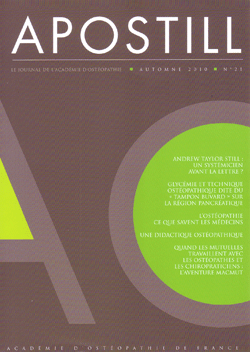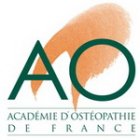Sommaire

- Éditorial, Jean Peyrière
- Andrew Taylor Still : un systémicien avant la lettre ? L’ostéopathie à la lumière du raisonnement systémique, C. Martin
Résumé
L’ostéopathie se fonde sur un concept de globalité. Elle s’est heurtée de ce fait pour sa reconnaissance au paradigme dominant du monde occidental : l’approche analytique développée en particulier par René Descartes à partir des principes d’Aristote. La méthodologie cartésienne a été à la base du développement des sciences, et au-delà, elle a imprégné nos consciences. Notre monde est encore largement bâti selon les principes réductionnistes et dualistes, qui transparaissent dans les domaines politique, industriel, pédagogique, et aussi médical.
Ce modèle est cependant actuellement remis en question et dépassé par l’avancée des sciences, et particulièrement depuis la deuxième moitié du XXe siècle. Au modèle disjonctif succède une approche qui se veut conjonctive, couramment appelée « raisonnement systémique ».
L’ostéopathie peut-elle se situer et se reconnaître dans son identité face à cette évolution ? Cette question et les enjeux qui s’y rattachent feront l’objet d’une série d’articles.
Le premier de ceux-ci résume ici le contexte sur lequel a émergé progressivement l’approche systémique, à partir de la découverte du principe d’entropie en physique.
Mots clés : réductionnisme, positivisme, approche systémique, constructivisme, complexité, pédagogie, ostéopathie.
- Glycémie et technique ostéopathique dite du « tampon buvard » sur la région pancréatique : effet après hyperglycémie par voie orale, A. Benbaruch, D. Lehougre, R. Meslé
Résumé
Une étude a montré qu’une pression variable sur les cellules pancréatiques in vitro modifiait la sécrétion d’insuline. Nous avons cherché à évaluer l’effet sur la glycémie dune technique ostéopathique par pression alternative sur la région pancréatique dite « du tampon buvard ».
Nous avons recruté 58 sujets sains, répartis par randomisation en deux groupes. Lors de la première séance, nous avons provoqué chez tous les sujets une hyperglycémie par voie orale (HGPO), et avons contrôlé la glycémie capillaire pendant les deux heures suivantes grâce à un système d’auto surveillance glycémique constitué de lancettes à usage unique, de languettes et d’un lecteur de glycémie. Nous avons observé la même courbe pour les deux groupes : augmentation de la glycémie jusqu’à obtention d’un pic d’hyperglycémie puis diminution jusqu’à la valeur initiale. Lors de la deuxième séance, après l’HGPO, nous avons effectué la technique ostéopathique pour les sujets de groupe traité et avons mesuré un pic d’hyperglycémie moins important (p<0,0001). Les sujets du groupe témoin ont reçu une technique simulée et ont présenté la même courbe que lors de la première séance.
La technique ostéopathique dite du "tampon buvard" sur la région pancréatique favoriserait la sécrétion d’insuline par les cellules béta des îlots de Langerhans et régulerait la glycémie chez des sujets sains. Il serait intéressant d’évaluer son efficacité auprès de patients diabétiques
Mots clefs : pancréas, glycémie, insuline, technique ostéopathique.
- L’ostéopathie - Ce que savent les médecins - Enquête auprès de 112 médecins généralistes de Paris, L. de Laroullière, T. Heimburger
Résumé
L’ostéopathie est une profession de première intention nouvellement réglementée en France. Dans ce contexte de reconnaissance légale, nous avons voulu déterminer ce que les médecins généralistes savent de cette profession aux multiples visages.
Nous nous sommes appuyés sur une revue de littérature puis sur une enquête que nous avons menée auprès de 287 généralistes de Paris et dont nous avons analysé 112 réponses.
Cette étude nous a permis de montrer que 84% des médecins trouvent l’ostéopathie utile ou nécessaire. Loin d’être réfractaires, les médecins se montrent toutefois prudents car ils sont très peu informés sur le statut, les conditions d’exercice et l’étendue des champs d’application : 70% se considèrent en effet peu ou mal informés.
Nous retenons de cette étude qu’il est nécessaire d’informer au plus vite les partenaires directs que sont les médecins pour une installation pérenne de l’ostéopathie dans le parcours de soin français.
Mots clés : ostéopathie, médecin généraliste, enquête.
- Une didactique ostéopathique : quelques réflexions d’épistémologie, N. Pinelli
Actualités
- Quand les mutuelles travaillent avec les ostéopathes et les chiropraticiens : l’aventure MacMut
- Trois questions au Professeur Pierre Cornillot
Lire
- Livres
- Thrust, sémiologie, imagerie - Indications en ostéopathie vertébrale. M. Fischer, B. Erieau
- Traité de médecine ostéopathique du crâne et de l’articulation temporomandibulaire. F. Ricard
- Anatomie fonctionnelle appliquée à l’ostéopathie crânienne. N. Sergueef
- Ostéopathie viscérale : recueil des techniques palpatoires et diagnostiques selon Frantz GLÉNARD. B. Buttet-Miquel
- Revue des Revues
- Ostéo, la revue n° 86 - Avril 2010
- L’Ostéo4pattes n° 16 - Mars 2010
- L’ostéopathe magazine n° 3 - Juillet - Août 2010
ApoStill n° 21 - Autumn 2010 - Summary
- Foreword, Jean Peyrière
- Andrew Taylor Still - Into systemics before time ? Osteopathy in the light of Systemics, C. Martin
Abstract
Osteopathy is based on the concept of wholeness. lts recognition has been therefore faced with the main western world paradigm : the analytical approach mainly developped by René Descartes from Aristotle’s principles. Cartesian methodology was the basis for the development of science and beyond that, it permeated our conciousness. Our world is still greatly built on reductionist and dualistic principles, which shows through politics, industry, pedagogy, and also medicine.
However, this pattern is now being questioned and overtaken by the advance of science, particularly since the second half of the XXth century. The disjunctive way is followed by a more conjunctive approach, commonly called « systemical reasoning ».
Can osteopathy find its place and recognize its own identity in this evolution ? The question and what is at stake will be developped in a series of articles.
The first one here summarizes the context in which the systemical approach progressively emerged, starting with the discovery of the principle of entropy in Physics.
Keywords : reductionnism, positivism, systemism, constructivism, complexity, pedagogy, osteopathy.
- Glycaemia and osteopathic technique known as the "blotter technique" on the pancreatic region : effect after an oral glucose tolerance test, A. Benbaruch, D. Lehougre, R. Meslé
Abstract
A study has showed that a variable pressure on the pancreatic cells in-vitro modified the secretion of insulin. Thus, we tried to estimate the effect of the alternative pressure on the glycaemia with an osteopathic technique known as the "blotter technique" on the pancreatic region. For that purpose, we recruited 58 healthy subjects, divided in 2 groups by randomisation. For the first session, we applied an oral glucose tolerance test (GTT) on the two groups and assessed the capillary glycaemia during the following two hours by means of a gly-caemic self-assessment system established by disposable lancets, strips and glycaemia reader. We observed the same curve for the 2 groups : an increase of the glycaemia up to an hyperglycaemia peak, then a decrease toward the initial value. During the second session, the GTT was followed by the implementation of the osteopathic technique on the subjects of the treatment group, and measured a lesser peak in their glycaemia curve (p<0,0001). The control group received a sham technique and presented a curve similar to the first session. Thus it seems that the use of the Blotter technique on the pancreatic region could help to stimulate secretion of insulin by 8 cells of the islets of Langerhans and so regulate the glycaemia of healthy subjects. It would be interesting to evaluate its potential with diabetic patients.
Keywords : pancreas, glycemia, insulin, osteopathic technique.
- What medical practitioners know about osteopathy Survey amongst 112 general practitioners based in Paris, L. de Laroullière, T. Heimburger
- A teaching method applied to osteopathy : a few epistemologic reflections, N. Pinelli
Abstract
Osteopathy is a newly legalised profession in France. We therefore wanted to find out what general practitioners knew about its multiple aspects in this particular context.
We worked on a literary review and then realised a survey that gathered 112 answers by general practitioners of Paris.
This study showed us that 84% of the GPs find osteopathy useful or necessary. Far from being reluctant, they remain cautious because they are very poorly informed on its status and its wide range of possibilities : 70% consider themselves poorly or badly informed.
We come out of this study with the firm belief that it is necessary to inform as soon as possible these close partners so that osteopathy can have a firm and long lasting position in the French medical sys-tem.
Key words : osteopathy, general practitioner, survey.
News
- MacMut : an example of collaboration between private health insurances and osteopaths and chiropractors
- Three questions asked to Pr Pierre Cornillot
Read
- Books
- Thrust, sémiologie, imagerie - Indications en ostéopathie vertébrale. M. Fischer, B. Erieau
- Traité de médecine ostéopathique du crâne et de l’articulation temporomandibulaire. F. Ricard
- Anatomie fonctionnelle appliquée à l’ostéopathie crânienne. N. Sergueef
- Ostéopathie viscérale : recueil des techniques palpatoires et diagnostiques selon Frantz GLÉNARD. B. Buttet-Miquel
- Publications review
- Ostéo, la revue n° 86 - Avril 2010
- L’Ostéo4pattes n° 16 - Mars 2010
- L’ostéopathe magazine n° 3 - Juillet - Août 2010




